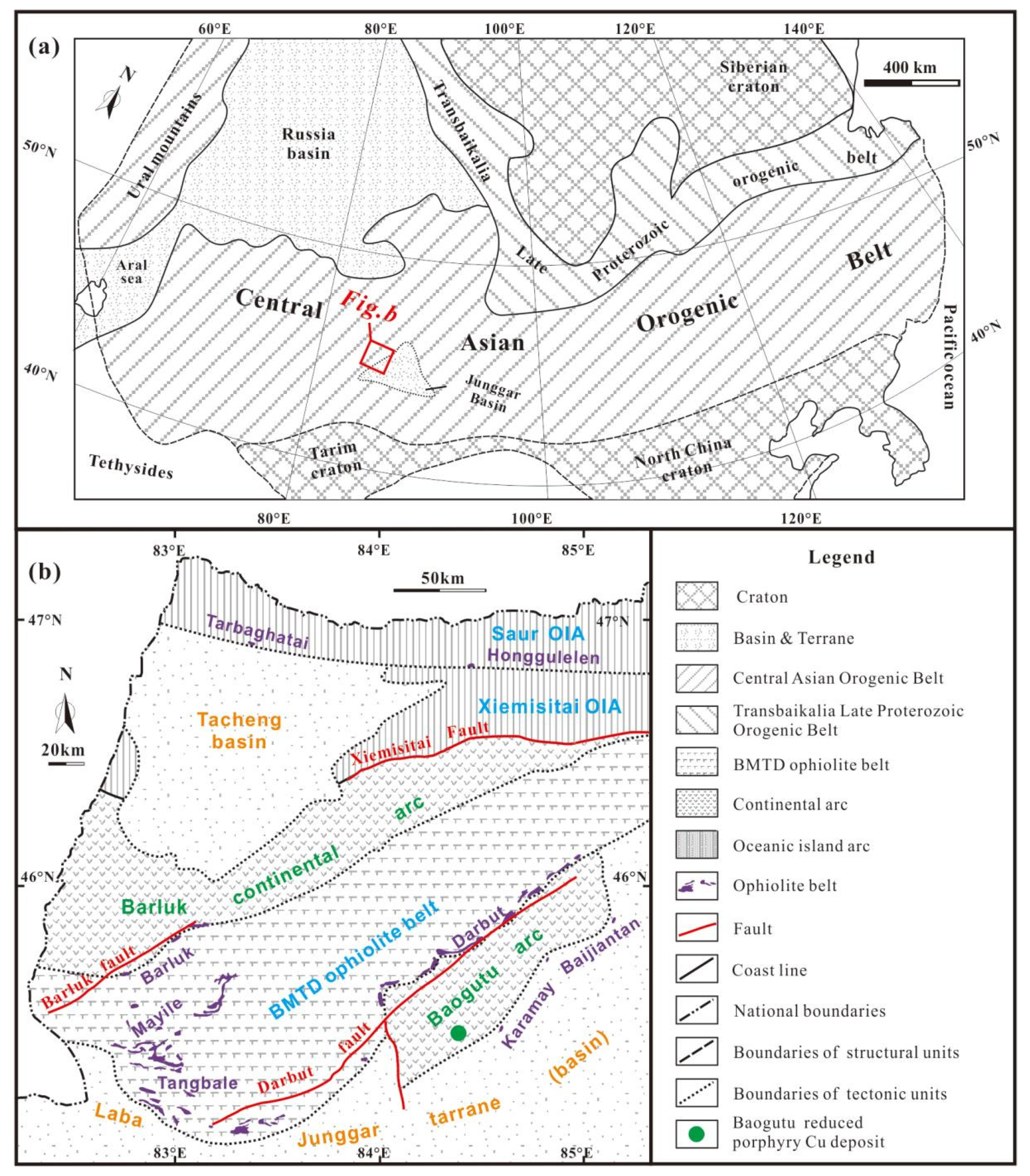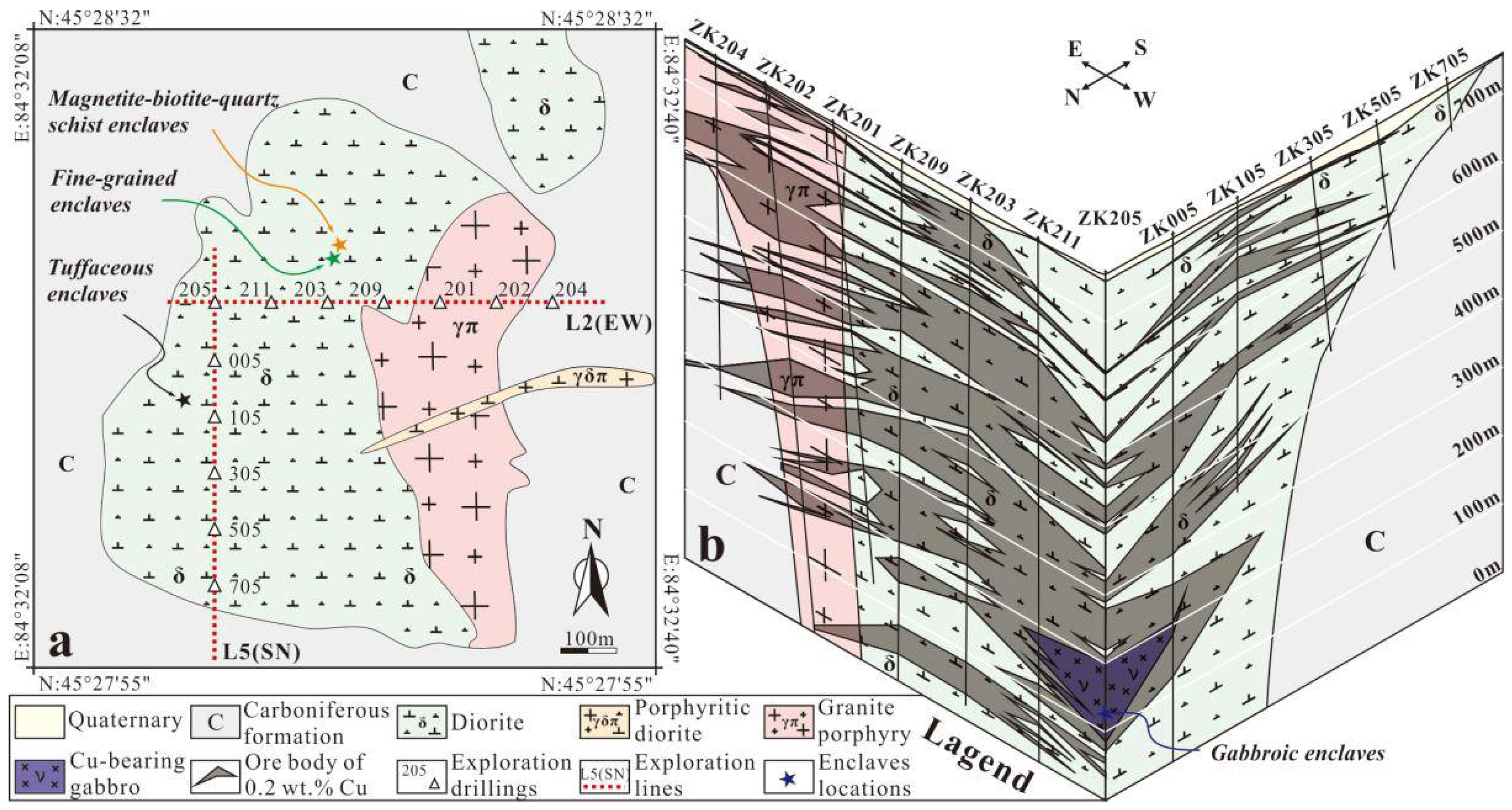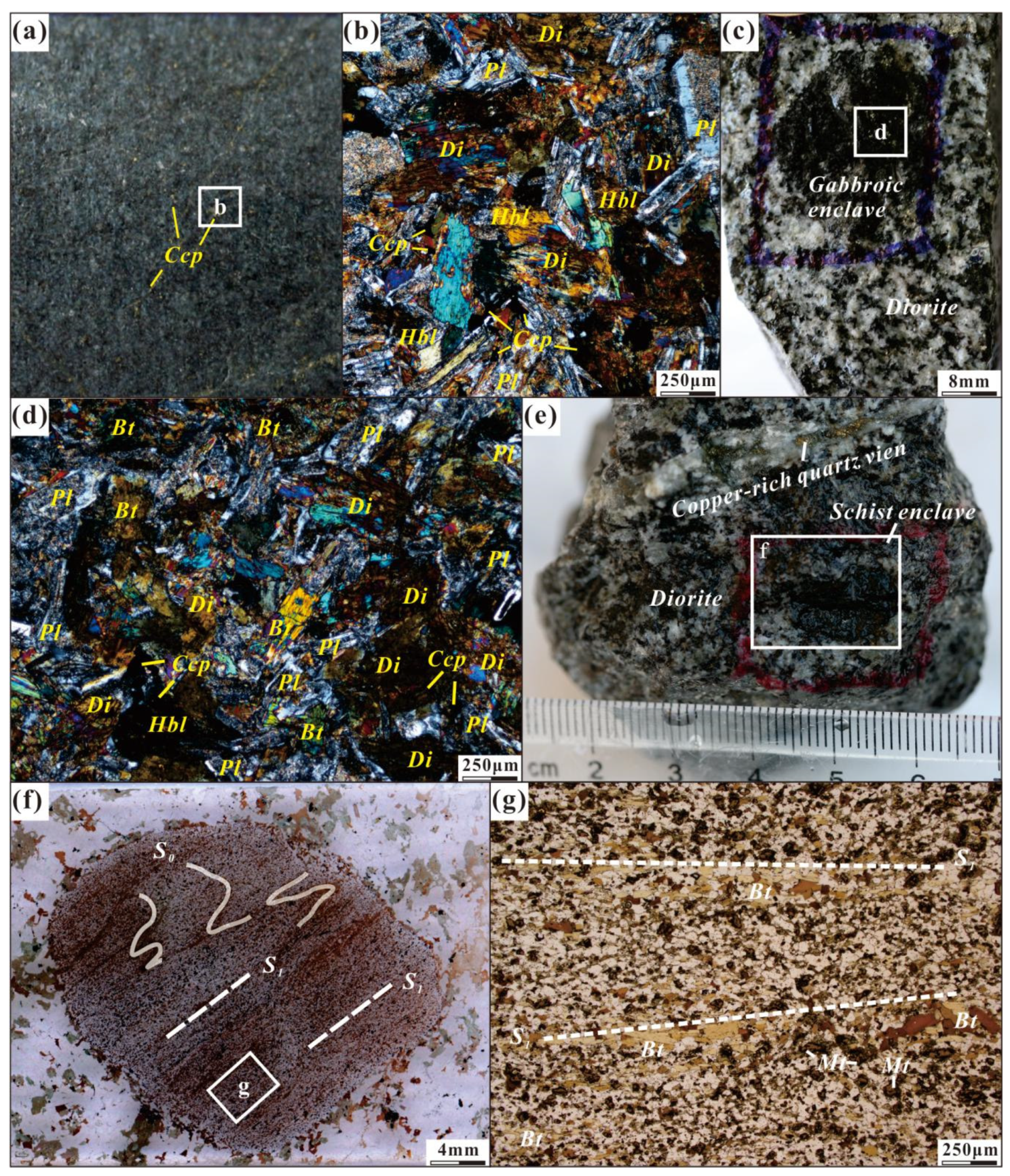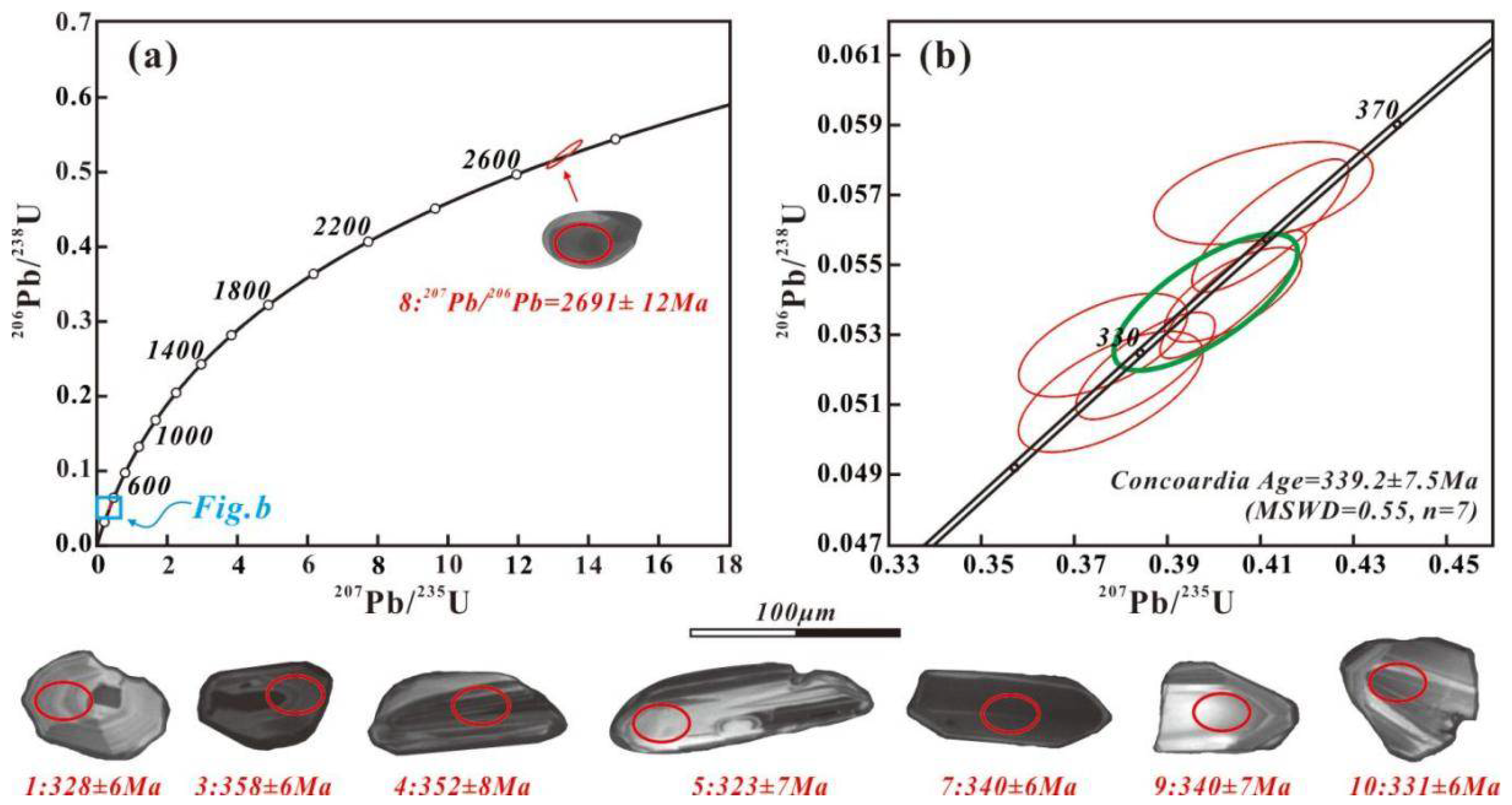Magmatic Process Associated with the Baogutu Reduced Cu Porphyry-Type Deposit (West Junggar, Northwest China): Evidence from Multiple Enclaves
Abstract
:1. Introduction
2. Geological Setting
2.1. Regional Geology
2.2. Intrusive Complex
2.3. Alteration
2.4. Mineralization
3. Enclave Petrography
4. Sample Selection and Analytical Techniques
5. Analytical Results
6. Discussion
6.1. Petrogenesis of the Enclaves
6.1.1. Gabbroic Enclave (Type 1)
6.1.2. Schist Enclave (Type 2)
6.1.3. Fine-Grained Dioritic Enclaves (Type 3)
6.1.4. Tuffaceous Siltstone Enclave (Type 4)
6.2. Magma Process
6.2.1. Source Features
6.2.2. Fractional Crystallization
6.2.3. Contamination
6.3. Tectonic Implication
7. Conclusions
Author Contributions
Funding
Acknowledgments
Conflicts of Interest
References
- Seedorff, E.; Dilles, J.H.; John, M.; Proffett, J.; Einaudi, M.T.; Zurcher, L.; Stavast, W.J.A.; Johnson, D.A.; Barton, M.D. Porphyry deposits: Charcteristics and origin of hypogene features. In Economic Geology One Hundredth Anniversary Volume 1905–2005; Hedenquist, J.W., Thompson, J.F.H., Goldfarb, R.J., Richards, J.P., Eds.; Society of Economic Geologists: Littleton, CO, USA, 2005; pp. 251–298. [Google Scholar]
- Sillitoe, R.H. Porphyry copper systems. Econ. Geol. 2010, 105, 3–41. [Google Scholar] [CrossRef] [Green Version]
- Xu, X.W.; Li, H.; Peters, S.G.; Qin, K.Z.; Mao, Q.; Wu, Q.; Hong, T.; Wu, C.; Liang, G.L.; Zhang, Z.F.; et al. Cu-rich porphyry magmas produced by fractional crystallization of oxidized fertile basaltic magmas (Sangnan, East Junggar, PR China). Ore Geol. Rev. 2017, 91, 296–315. [Google Scholar] [CrossRef]
- Wang, Y.H.; Zhang, F.F.; Xue, C.J.; Liu, J.J.; Zhang, Z.C.; Sun, M. Geology and Genesis of the Tuwu Porphyry Cu Deposit, Xinjiang, Northwest China. Economic Geology. Econ. Geol. 2021, 116, 471–500. [Google Scholar] [CrossRef]
- Hong, T.; Xu, X.W.; Gao, J.; Peters, S.G.; Zhang, D.; Jielili, R.; Xiang, P.; Li, H.; Wu, C.; You, J.; et al. Ore-forming adakitic porphyry produced by fractional crystallization of oxidized basaltic magmas in a subcrustal chamber (Jiamate, East Junggar, NW China). Lithos 2018, 296, 96–112. [Google Scholar] [CrossRef]
- Hedenquist, J.W.; Lowenstern, J.B. The role of magmas in the formation of hydrothermal ore deposits. Nature 1994, 370, 519–527. [Google Scholar] [CrossRef]
- Cao, M.J.; Qin, K.Z.; Li, G.M.; Jin, L.Y.; Evans, N.J.; Yang, X.R. Baogutu: An example of reduced porphyry Cu deposit in western Junggar. Ore Geol. Rev. 2014, 56, 159–180. [Google Scholar] [CrossRef]
- Shen, P.; Pan, H.D. Country-rock contamination of magmas associated with the Baogutu porphyry Cu deposit, Xinjiang, China. Lithos 2013, 177, 451–469. [Google Scholar] [CrossRef]
- Cao, M.J.; Qin, K.Z.; Li, G.M.; Yang, Y.H.; Evans, N.J.; Zhang, R.; Jin, L.Y. Magmatic process recorded in plagioclase at the Baogutu reduced porphyry Cu deposit, western Junggar, NW-China. J. Asian Earth Sci. 2014, 82, 136–150. [Google Scholar] [CrossRef]
- Cao, M.J.; Qin, K.Z.; Li, G.M.; Evans, N.J.; Hollings, P.; Jin, L.Y. Genesis of ilmenite series I-type granitoids at the Baogutu reduced porphyry Cu deposit, western Junggar, NW-China. Lithos 2016, 246, 13–30. [Google Scholar] [CrossRef]
- Cao, M.J.; Qin, K.Z.; Li, G.M.; Evans, N.J.; Jin, L.Y. Abiogenic Fischer–Tropsch synthesis of methane at the Baogutu reduced porphyry copper deposit, western Junggar, NW-China. Geochim. Cosmochim. Acta 2014, 141, 179–198. [Google Scholar] [CrossRef]
- Core, D.P.; Kesler, S.E.; Essene, E.J. Unusually Cu-rich magmas associated with giant porphyry copper deposits: Evidence from Bingham, Utah. Geology 2006, 34, 41–44. [Google Scholar] [CrossRef]
- Wu, S.; Zheng, Y.Y.; Sun, X.; Liu, S.A.; Geng, R.R.; You, Z.M.; Ouyang, H.T.; Lei, D.; Zhao, Z.Y. Origin of the Miocene porphyries and their mafic microgranular enclaves from Dabu porphyry Cu-Mo deposit, southern Tibet: Implications for magma mixing/mingling and mineralization. Int. Geol. Rev. 2014, 56, 571–595. [Google Scholar] [CrossRef]
- Zhao, X.B.; Xue, C.J.; Symons, D.T.A.; Zhang, Z.C.; Wang, H.G. Microgranular enclaves in island-arc andesites: A possible link between known epithermal Au and potential porphyry Cu–Au deposits in the Tulasu ore cluster, western Tianshan, Xinjiang, China. J. Asian Earth Sci. 2014, 85, 210–223. [Google Scholar] [CrossRef]
- Zhang, F.F.; Wang, Y.H.; Liu, J.J.; Xue, C.J.; Wang, J.P.; Zhang, W.; Li, Y.Y. Paleozoic Magmatism and Mineralization Potential of the Sanchakou Copper Deposit, Eastern Tianshan, Northwest China: Insights from Geochronology, Mineral Chemistry, and Isotopes. Econ. Geol. 2022, 117, 165–194. [Google Scholar] [CrossRef]
- Sengör, A.M.C.; Natal’in, B.A. Paleotectonics of Asia: Fragments of a synthesis. In The Tectonic Evolution of Asia; Yin, A., Harrison, M., Eds.; Cambridge University Press: Rubey Colloquium, Cambridge, UK, 1996; pp. 486–640. [Google Scholar]
- Windley, B.F.; Alexeiev, D.; Xiao, W.J.; Kroner, A.; Badarch, G. Tectonic models for accretion of the Central Asian Orogenic Belt. J. Geol. Soc. Lond. 2007, 164, 31–47. [Google Scholar] [CrossRef] [Green Version]
- Xu, X.W.; Jiang, N.; Li, X.H.; Wu, C.; Qu, X.; Zhou, G.; Dong, L.H. Spatial-temporal framework for the closure of the Junggar Ocean in Central Asia: New SIMS zircon U-Pb ages of the ophiolitic mélange and collisional igneous rocks in the Zhifang area, East Junggar. J. Asian Earth Sci. 2015, 111, 470–491. [Google Scholar] [CrossRef]
- Wu, C.; Hong, T.; Xu, X.W.; Cao, M.J.; Li, H.; Zhang, G.L.; You, J.; Ke, Q.; Dong, L.H. Tectonic evolution of the Paleozoic Barluk continental arc, West Junggar, NW China. J. Asian Earth Sci. 2018, 160, 48–66. [Google Scholar] [CrossRef]
- Wu, C.; Hong, T.; Xu, X.W.; Cao, M.J.; Li, H.; Ke, Q.; Li, H.; Dong, L.H. Constraints on the formation of the Baogutu reduced porphyry copper deposit (West Junggar, NW China): Assessing the role of mafic magmas in mineralization. Lithos 2019, 336, 112–124. [Google Scholar] [CrossRef]
- Xu, X.W.; Jiang, N.; Li, X.H.; Qu, X.; Yang, Y.H.; Mao, Q.; Wu, Q.; Zhang, Y.; Dong, L.H. Tectonic evolution of the East Junggar terrane: Evidence from the Taheir tectonic window, Xinjiang, China. Gondwana Res. 2013, 24, 578–600. [Google Scholar] [CrossRef]
- Zhu, Y.F.; Chen, B.; Xu, X.; Qiu, T.; An, F. A new geological map of the western Junggar, north Xinjiang (NW China): Implications for Paleoenvironmental reconstruction. Episodes 2013, 36, 205–220. [Google Scholar] [CrossRef] [Green Version]
- Wu, C.; Hong, T.; Xu, X.W.; Li, H.; Ke, Q.; Li, H.; Dong, L.H. Constraints on the nature of the basement of the Junggar terrane indicated by the Laba Ordovician continental arc. Int. Geol. Rev. 2020, 62, 29–52. [Google Scholar] [CrossRef]
- Jian, P.; Liu, D.Y.; Shi, Y.R.; Zhang, F.Q. SHRIMP dating of SSZ ophiolites from northern Xinjiang Province, China: Implications for generation of oceanic crust in the Central Asian Orogenic Belt. In Structural and Tectonic Correlation across the Central Asia Orogenic Collage: North-Eastern Segment; Sklyarov, E.V., Ed.; Guidebook and Abstract Volume of the Siberian Workshop IGCP-480; IEC SB RAS: Irkutsk, Russia, 2005; p. 246. [Google Scholar]
- Yang, G.X.; Li, Y.J.; Santosh, M.; Yang, B.K.; Yan, J.; Zhang, B.; Tong, L.L. Geochronology and geochemistry of basaltic rocks from the Sartuohai ophiolitic mélange, NW China: Implications for a Devonian mantle plume within the Junggar Ocean. J. Asian Earth Sci. 2012, 59, 141–155. [Google Scholar] [CrossRef]
- An, F.; Zhu, Y.F. SHRIMP U-Pb zircon ages of tuff in Baogutu Formation and their geological significances. Acta Petrol. Sin. 2009, 25, 1437–1445, (In Chinese with English Abstract). [Google Scholar]
- Tang, G.J.; Wang, Q.; Zhao, Z.H.; Derek, A.W.; Chen, H.H.; Jia, X.H.; Jiang, Z.Q. Geochronology and geochemistry of the Ore-bearing porphyries in the Baogutu Area (Western Junggar): Petrogenesis and their implications for tectonics and Cu-Au mineralization. Earth Sci. J. China Univ. Geosci. 2009, 34, 56–74, (In Chinese with English Abstract). [Google Scholar]
- Shen, P.; Shen, Y.C.; Pan, H.D.; Wang, J.B.; Zhang, R.; Zhang, Y.X. Baogutu porphyry Cu-Mo-Au deposit, West Junggar, Northwest China: Petrology, alteration, and mineralization. Econ. Geol. 2010, 105, 947–970. [Google Scholar] [CrossRef]
- Yin, J.Y.; Long, X.P.; Yuan, C.; Sun, M.; Zhao, G.C.; Geng, H.Y. A Late Carboniferous slab window: Geochronological and geochemical evidence from mafic to intermediate dykes in West Junggar, NW China. Lithos 2013, 175, 146–162. [Google Scholar] [CrossRef]
- Yin, J.Y.; Chen, W.; Xiao, W.J.; Yuan, C.; Sun, M.; Tang, G.J.; Yu, S.; Long, X.P.; Cai, K.D.; Geng, H.Y.; et al. Petrogenesis of Early-Permian sanukitoids from West Junggar, Northwest China: Implications for Late Paleozoic crustal growth in Central Asia. Tectonophysics 2015, 662, 385–397. [Google Scholar] [CrossRef]
- Buckman, S.; Aitchison, J.C. Tectonic evolution of Palaeozoic terranes in West Junggar, Xinjiang, NW China. In Aspects of the Tectonic Evolution of China; Malpas, J., Fletcher, C.J.N., Ali, J.R., Aitchison, J.C., Eds.; Geological Society of London Special Publications: London, UK, 2004; Volume 226, pp. 101–129. [Google Scholar]
- Wiedenbeck, M.; Alle, P.; Corfu, F.; Griffin, W.L.; Meier, M.; Oberli, F.; Vonquadt, A.; Roddick, J.C.; Speigel, W. Three natural zircon standards for U-Th-Pb, Lu-Hf, trace-element and REE analyses. Geostand. Newsl. 1995, 19, 1–23. [Google Scholar] [CrossRef]
- Li, X.H.; Liu, Y.; Li, Q.L.; Guo, C.H.; Chamberlain, K.R. Precise determination of Phanerozoic zircon Pb/Pb age by multicollector SIMS without external standardization. Geochem. Geophy. Geosy. 2009, 10, Q04010. [Google Scholar] [CrossRef]
- Li, Q.L.; Li, X.H.; Liu, Y.; Tang, G.Q.; Yang, J.H.; Zhu, W.G. Precise U-Pb and Pb-Pb dating of Phanerozoic baddeleyite by SIMS with oxygen flooding technique. J. Anal. At. Spectrom. 2010, 25, 1107–1113. [Google Scholar] [CrossRef]
- Stacey, J.S.; Kramers, J.D. Approximation of terrestrial lead isotope evolution by a two-stage model. Earth Planet. Sci. Lett. 1975, 26, 207–221. [Google Scholar] [CrossRef]
- Ludwig, K.R. SQUID 1.02: A User’s Manual; Special Publication 2; Berkeley Geochronology Center: Berkeley, CA, USA, 2001; pp. 1–19. [Google Scholar]
- Corfu, F.; Hanchar, J.M.; Hoskin, P.W.O.; Kinny, P. Atlas of zircon textures. Rev. Mineral. Geochem. 2003, 53, 469–500. [Google Scholar] [CrossRef]
- Hoskin, P.W.O.; Black, L.P. Metamorphic zircon formation by solid-state recrystallization of protolith igneous zircon. J. Metamorph. Geol. 2000, 18, 423–439. [Google Scholar] [CrossRef]
- Didier, J. Granites and their enclaves. In Developments in Petrology; Elsevier: Amsterdam, The Netherlands, 1973; p. 393. [Google Scholar]
- Didier, J.; Barbarin, B. Enclaves and granite petrology. In Developments in Petrology; Elsevier: Amsterdam, The Netherlands, 1991; p. 625. [Google Scholar]
- Mass, R.; Nicholls, I.A.; Legg, C. Igneous and metamorphic enclaves in the S-type Deddick granodiorite, Lachlan fold belt, SE Australia: Petrographic, geochemical and Nd–Sr isotopic evidence for crustal melting and magma mixing. J. Pet. 1997, 38, 815–841. [Google Scholar] [CrossRef]
- Bouloton, J.; Gasquet, D. Melting and undercooled crystalisation of felsic xenoliths from minor intrusions (Jebilet massif, Morocco). Lithos 1995, 35, 201–219. [Google Scholar] [CrossRef]
- Guo, L.S.; Liu, Y.L.; Wang, Z.H.; Song, D.; Xu, F.J.; Su, L. The zircon U-Pb LA-ICP-MS geochronology of volcanic rocks in Baogutu areas, western Junggar. Acta Petrol. Sin. 2010, 26, 471–477, (In Chinese with English Abstract). [Google Scholar]
- Shen, P.; Shen, Y.C.; Liu, T.B.; Meng, L.; Dai, H.W.; Yang, Y.H. Geochemical signature of porphyries in the Baogutu porphyry copper belt, western Junggar, NW China. Gondwana Res. 2009, 16, 227–242. [Google Scholar] [CrossRef]
- Wu, C.; Hong, T.; Xu, X.W.; Wang, C.X.; Dong, L.H. A-type granites induced by a breaking-off and delamination of the subducted Junggar oceanic plate, West Junggar, Northwest China. China Geol. 2021, 4, 1–18. [Google Scholar] [CrossRef]
- Zhu, Y.F.; Xu, X.; Wei, S.N.; Song, B.; Guo, X. Geochemistry and tectonic significance of OIB-type pillow basalts in western Mts. of Karamay city (western Junggar), NW China. Acta Petrol. Sin. 2007, 23, 1739–1748, (In Chinese with English Abstract). [Google Scholar]
- Bailey, J.C. Geochemical criteria for a refined tectonic discrimination of orogenic andesites. Chemi. Geol. 1981, 32, 139–154. [Google Scholar] [CrossRef]
- Shao, W.Y.; Chung, S.L.; Chen, W.S.; Lee, H.Y.; Xie, L.W. Old continental zircons from a young oceanic arc, eastern Taiwan: Implications for Luzon subduction initiation and Asian accretionary orogeny. Geology 2015, 43, 479–482. [Google Scholar] [CrossRef]
- Smyth, H.R.; Hamilton, P.J.; Hall, R.; Kinny, P.D. The deep crust beneath island arcs: Inherited zircons reveal a Gondwana continental fragment beneath East Java, Indonesia. Earth Planet. Sci. Lett. 2007, 258, 269–282. [Google Scholar] [CrossRef]
- Tapster, S.; Roberts, N.M.W.; Petterson, M.G.; Saunders, A.D.; Naden, J. From continent to intra-oceanic arc: Zircon xenocrysts record the crustal evolution of the Solomon island arc. Geology 2014, 42, 1087–1090. [Google Scholar] [CrossRef]






| Sample No. | Content/10−6 | Th/U | 207Pb/206Pb | 207Pb/235U | 206Pb/238U | 207Pb/206Pb | 207Pb/235U | 206Pb/238U | f206% | |||||||
|---|---|---|---|---|---|---|---|---|---|---|---|---|---|---|---|---|
| Th | U | Ratio | ±σ | Ratio | ±σ | Ratio | ±σ | Age/Ma | ±σ | Age/Ma | ±σ | Age/Ma | ±σ | |||
| 13BGT04-B@1 | 111 | 134 | 0.8 | 0.38535 | 2.56 | 0.05359 | 1.67 | 0.05220 | 1.94 | 353.9 | 37.3 | 327.7 | 6.2 | 331.0 | 7.3 | {0.18} |
| 13BGT04-B@3 | 74 | 179 | 0.4 | 0.41073 | 3.78 | 0.05217 | 3.38 | 0.05710 | 1.70 | 292.7 | 75.3 | 358.0 | 5.9 | 349.4 | 11.2 | {0.83} |
| 13BGT04-B@4 | 282 | 232 | 1.2 | 0.41216 | 2.69 | 0.05322 | 1.50 | 0.05620 | 2.24 | 338.1 | 33.5 | 352.3 | 7.7 | 350.4 | 8.0 | {0.00} |
| 13BGT04-B@5 | 65 | 92 | 0.7 | 0.37791 | 3.46 | 0.05331 | 2.65 | 0.05140 | 2.22 | 342.2 | 58.9 | 323.2 | 7.0 | 325.5 | 9.7 | {0.23} |
| 13BGT04-B@7 | 343 | 266 | 1.3 | 0.40419 | 2.56 | 0.05408 | 1.25 | 0.05420 | 2.24 | 374.6 | 28.0 | 340.3 | 7.4 | 344.7 | 7.5 | {0.38} |
| 13BGT04-B@8 | 35 | 98 | 0.4 | 13.30594 | 2.49 | 0.18423 | 0.74 | 0.52380 | 2.38 | 2691.3 | 12.3 | 2715.4 | 52.9 | 2701.6 | 23.8 | {0.02} |
| 13BGT04-B@9 | 127 | 164 | 0.8 | 0.40421 | 2.41 | 0.05410 | 1.75 | 0.05420 | 1.65 | 375.1 | 39.0 | 340.2 | 5.5 | 344.7 | 7.1 | {0.59} |
| 13BGT04-B@10 | 105 | 106 | 1.0 | 0.37627 | 3.18 | 0.05174 | 2.58 | 0.05270 | 1.85 | 273.9 | 58.1 | 331.4 | 6.0 | 324.3 | 8.9 | {0.36} |
Publisher’s Note: MDPI stays neutral with regard to jurisdictional claims in published maps and institutional affiliations. |
© 2022 by the authors. Licensee MDPI, Basel, Switzerland. This article is an open access article distributed under the terms and conditions of the Creative Commons Attribution (CC BY) license (https://creativecommons.org/licenses/by/4.0/).
Share and Cite
Wu, C.; Hong, T.; Xu, X.-W.; Zheng, X.; Wang, C.-X.; Liang, W.-J.; Sun, K.-F.; Zhang, H.-J.; Wang, B.; Dong, L.-H. Magmatic Process Associated with the Baogutu Reduced Cu Porphyry-Type Deposit (West Junggar, Northwest China): Evidence from Multiple Enclaves. Minerals 2022, 12, 815. https://doi.org/10.3390/min12070815
Wu C, Hong T, Xu X-W, Zheng X, Wang C-X, Liang W-J, Sun K-F, Zhang H-J, Wang B, Dong L-H. Magmatic Process Associated with the Baogutu Reduced Cu Porphyry-Type Deposit (West Junggar, Northwest China): Evidence from Multiple Enclaves. Minerals. 2022; 12(7):815. https://doi.org/10.3390/min12070815
Chicago/Turabian StyleWu, Chu, Tao Hong, Xing-Wang Xu, Xiao Zheng, Cheng-Xi Wang, Wan-Juan Liang, Ke-Feng Sun, Hui-Jun Zhang, Bin Wang, and Lian-Hui Dong. 2022. "Magmatic Process Associated with the Baogutu Reduced Cu Porphyry-Type Deposit (West Junggar, Northwest China): Evidence from Multiple Enclaves" Minerals 12, no. 7: 815. https://doi.org/10.3390/min12070815






